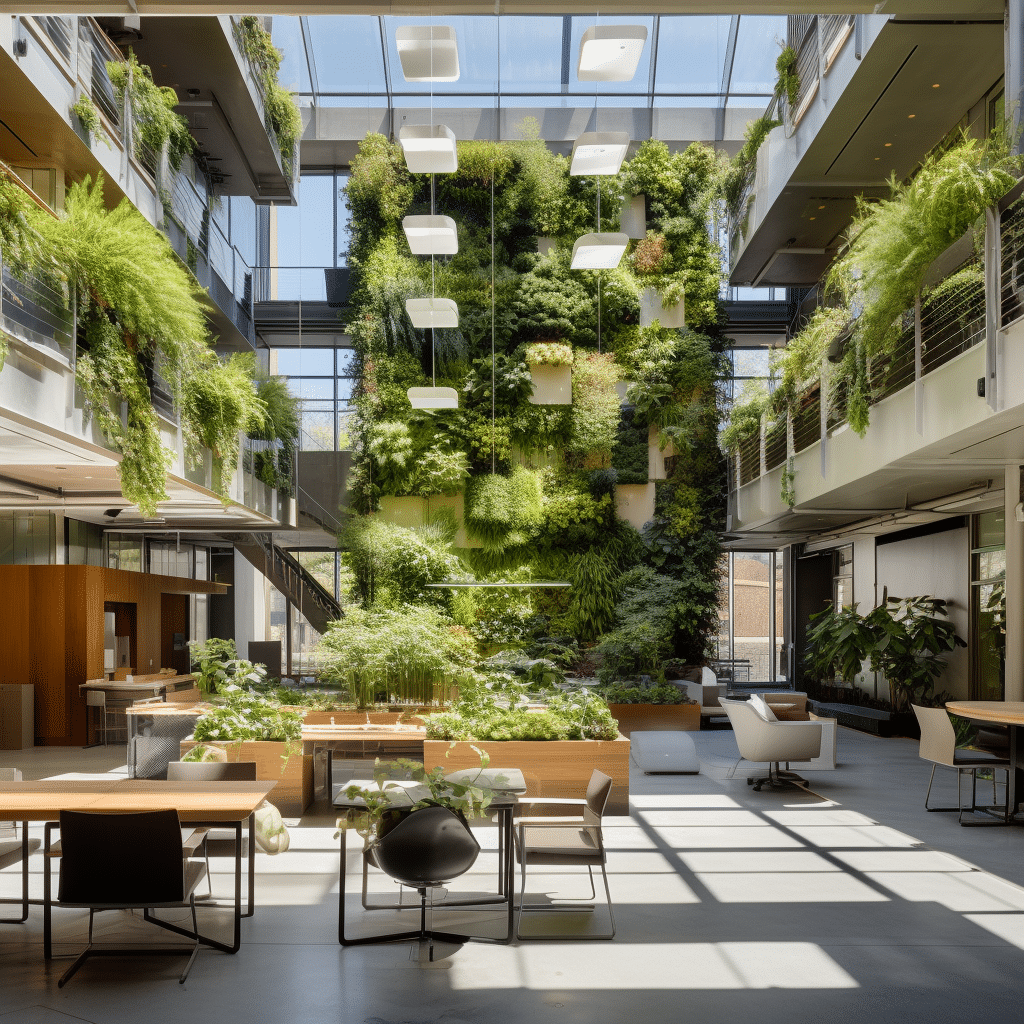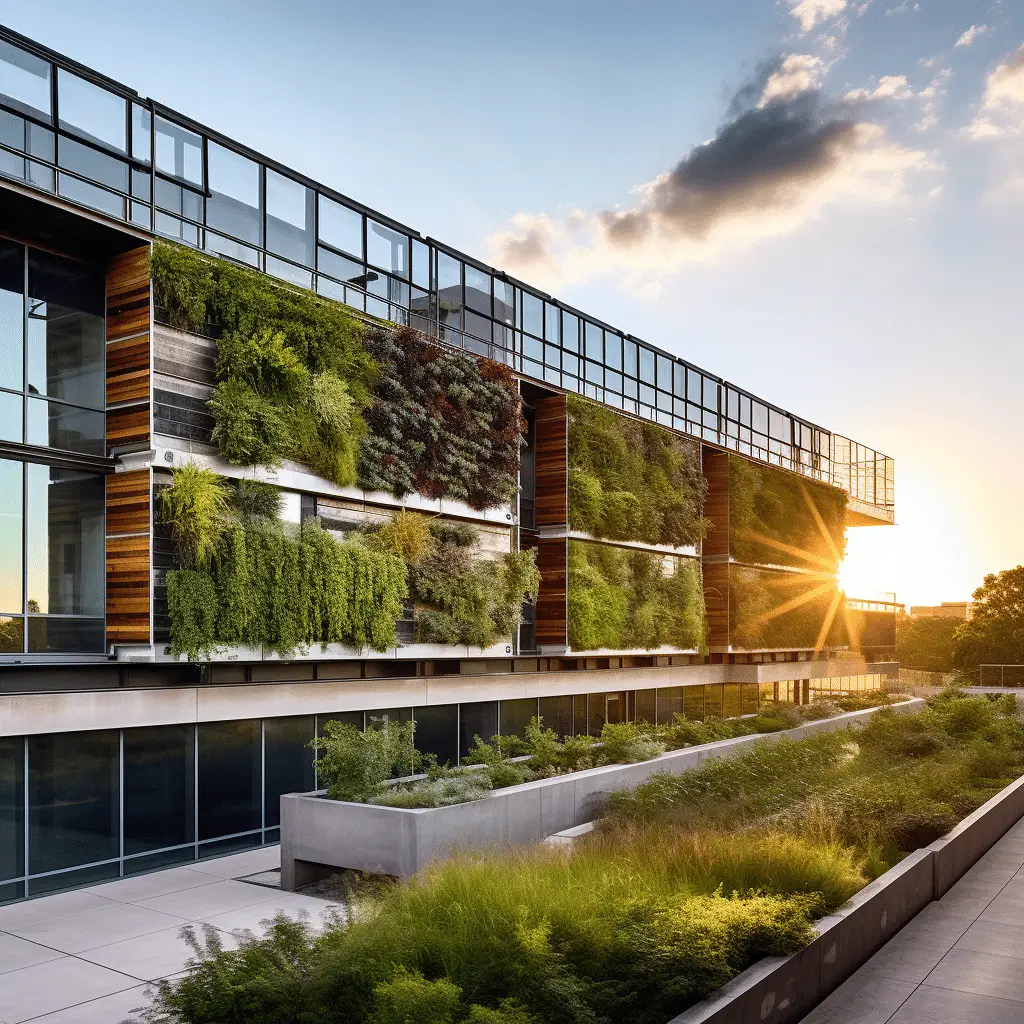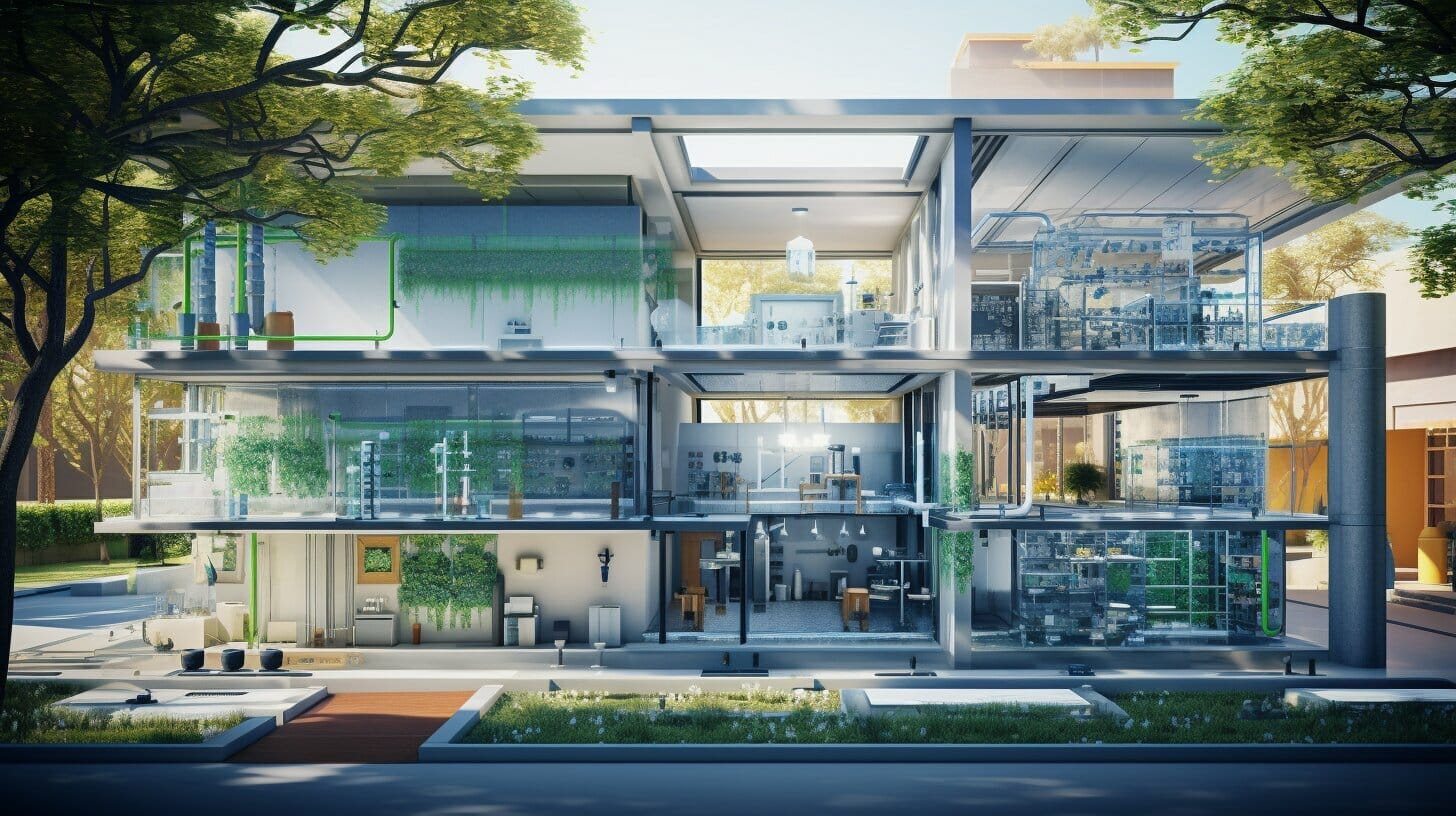WELL Certification Design Strategies: Creating Healthy Buildings
WELL Certification Design Strategies: Designing for WELL certification involves understanding and implementing the key concepts and criteria of the WELL Building Standard. The WELL certification is a performance-based system that evaluates the impact of the built environment on human health and well-being. It emphasizes seven factors: air, water, nourishment, light, fitness, comfort, and mind.
To create a healthy indoor environment, it is important to integrate design strategies and technologies that optimize these factors. This includes improving indoor air quality, providing access to clean water, promoting healthy eating habits, maximizing natural light, encouraging physical activity, ensuring thermal comfort, minimizing noise disruptions, using non-toxic materials, and creating spaces that support mental and emotional well-being.
Obtaining WELL certification involves a thorough certification process. Buildings must undergo onsite performance verification and documentation. Professionals overseeing the implementation of specific features must provide letters of assurance. The process includes registration, documentation requirements, performance verification, and the submission of a WELL report. There are also optional pathways for innovation and alternative adherence.
WELL certification offers a range of benefits. Achieving certification leads to improved occupant health and well-being, increased productivity, enhanced brand equity, cost savings, a baseline for ESG reporting, and improved occupant satisfaction. The certification is applicable to different types of buildings and can be achieved for both new and existing construction. Third-party validation is required for the certification process.
Key Takeaways:
- Design for WELL certification involves understanding and implementing the key concepts and criteria of the WELL Building Standard.
- The seven factors emphasized by the standard are air, water, nourishment, light, fitness, comfort, and mind.
- It is important to integrate design strategies and technologies that optimize these factors in order to create a healthy indoor environment.
- The certification process for WELL certification includes onsite performance verification, documentation requirements, and the submission of a WELL report.
- Achieving WELL certification offers numerous benefits, including improved occupant health and well-being, increased productivity, and enhanced brand equity.
Understanding the WELL Building Standard

The WELL Building Standard is a performance-based system that evaluates how the built environment affects human health and well-being. It focuses on seven key factors: air, water, nourishment, light, fitness, comfort, and mind. To design for WELL certification, it is crucial to have a deep understanding of these factors and how each one contributes to a healthy indoor environment.
By integrating these features and concepts into the design, buildings can achieve WELL certification. The certification process includes onsite performance verification and documentation, along with the submission of a detailed WELL report. It also requires letters of assurance from professionals overseeing the implementation of specific features. Third-party validation is an essential part of the certification process.
| Benefits of WELL Certification |
|---|
| Improved occupant health and well-being |
| Increased productivity |
| Enhanced brand equity |
| Cost savings |
| Baseline for ESG reporting |
| Improved occupant satisfaction |
WELL certification offers a range of benefits, including improved occupant health and well-being, increased productivity, enhanced brand equity, cost savings, a baseline for environmental, social, and governance (ESG) reporting, and improved occupant satisfaction. It serves as a recognized standard for designing buildings that prioritize human health and well-being.
Integrating Health and Well-being into Design
To achieve WELL certification, it is essential to integrate features and concepts that support health and well-being into the design. Design strategies and technologies play a crucial role in creating a healthy indoor environment that prioritizes the well-being of building occupants. Several factors should be considered, including indoor air quality, access to clean water, healthy eating habits, natural light, physical activity, thermal comfort, noise disruptions, non-toxic materials, and spaces that support mental and emotional well-being.
One of the key design strategies is improving indoor air quality. Additionally, providing access to clean water is important for occupant health. Designers should consider incorporating efficient water filtration systems and ensuring easy access to drinking water throughout the building.
Promoting healthy eating habits is another aspect of designing for WELL certification. Maximizing natural light is also crucial for the well-being of occupants. Designers should aim to maximize the use of natural daylight by implementing larger windows, skylights, and light shelves to reduce the reliance on artificial lighting.
| Design Strategy | Key Considerations |
|---|---|
| Improving Indoor Air Quality | Proper ventilation, air filters, non-toxic materials |
| Providing Access to Clean Water | Efficient water filtration systems, easily accessible drinking water |
| Promoting Healthy Eating Habits | Spaces for food preparation and communal dining, healthier food options |
| Maximizing Natural Light | Larger windows, skylights, light shelves |
Key Design Strategies for Integrating Health and Well-being
- Improving indoor air quality through proper ventilation and the use of non-toxic materials.
- Providing easy access to clean drinking water through efficient filtration systems.
- Promoting healthy eating habits by incorporating spaces for food preparation and offering healthier food options.
- Maximizing natural light by utilizing larger windows, skylights, and light shelves.
- Encouraging physical activity through dedicated spaces for exercise and promoting the use of stairs.
- Ensuring thermal comfort and minimizing noise disruptions through proper insulation and sound-absorbing materials.
- Creating spaces that support mental and emotional well-being, such as relaxation areas or green spaces.
Optimizing Air Quality and Water Access
Improving indoor air quality and providing access to clean water are crucial aspects of designing for WELL certification. These factors have a significant impact on occupant health and well-being, and there are specific strategies and technologies that can be implemented to optimize them.
When it comes to air quality, it is important to focus on reducing pollutants and maintaining proper ventilation. This can be achieved by using non-toxic materials, implementing effective filtration systems, and ensuring adequate airflow throughout the building. Additionally, monitoring and testing the air quality regularly is essential to ensure a healthy indoor environment.
Ensuring access to clean water is also a key consideration in WELL certification. Designers should prioritize the installation of water purification systems and implement measures to prevent contamination. Providing easy access to clean drinking water throughout the building encourages healthy hydration habits and supports overall well-being.
Strategies for Optimizing Air Quality and Water Access
Here are some strategies that can be implemented to optimize air quality and water access:
- Use non-toxic building materials and finishes that do not emit harmful chemicals.
- Install high-quality air filtration systems to remove pollutants and allergens.
- Ensure proper ventilation to maintain a fresh and healthy indoor environment.
- Regularly monitor and test air quality to identify and address any issues promptly.
- Implement water purification systems to provide clean and safe drinking water.
- Prevent water contamination by using plumbing fixtures and materials that meet or exceed industry standards.
- Encourage the use of reusable water bottles to reduce waste and promote sustainable practices.
By incorporating these strategies and technologies into the design, buildings can create a healthier and more sustainable environment that aligns with the WELL Building Standard and achieves WELL certification.
| Benefit of Optimizing Air Quality and Water Access | Explanation |
|---|---|
| Improved occupant health and well-being | By reducing pollutants and providing clean water, occupants are less likely to experience health issues related to poor air and water quality. |
| Increased productivity | A healthy indoor environment promotes better focus, concentration, and overall productivity among occupants. |
| Enhanced occupant satisfaction | Providing clean air and water contributes to the overall comfort and satisfaction of building occupants. |
Maximizing Natural Light and Encouraging Physical Activity
Incorporating natural light and opportunities for physical activity are essential elements of WELL certification design. These features not only enhance the aesthetic appeal of a space but also have a significant impact on the health and well-being of occupants. When designing for WELL certification, it is important to prioritize strategies that maximize natural light and promote physical activity within the built environment.
Natural light has been proven to improve mood, increase productivity, and regulate the body’s circadian rhythm. By incorporating large windows, skylights, and light-reflective surfaces, designers can optimize the amount of natural light that enters a space. This not only reduces reliance on artificial lighting but also creates a more comfortable and inviting atmosphere for occupants.
To encourage physical activity, designers should consider integrating features such as staircases, walkways, and exercise facilities into the building design. These elements promote movement and encourage occupants to engage in physical fitness activities throughout the day. Additionally, incorporating green spaces and outdoor areas can provide opportunities for outdoor exercise and relaxation.
By prioritizing natural light and physical activity in the design process, buildings can contribute to the overall health and well-being of occupants. These elements not only align with the principles of WELL certification but also create spaces that are more enjoyable, productive, and conducive to a healthy lifestyle.
| Benefits of Maximizing Natural Light and Encouraging Physical Activity: |
|---|
| 1. Improved mood and well-being |
| 2. Increased productivity and focus |
| 3. Regulation of circadian rhythm |
| 4. Reduction in energy consumption |
| 5. Promotion of physical fitness and well-being |
Ensuring Comfort and Minimizing Disruptions
Designing for WELL certification requires careful attention to thermal comfort and minimizing noise disruptions. These factors play a crucial role in creating a pleasant and productive indoor environment for building occupants.
To optimize thermal comfort, it is important to consider factors such as temperature, humidity, and air movement. With the right design strategies, buildings can maintain a comfortable and consistent temperature throughout the day. This can be achieved through proper insulation, efficient HVAC systems, and the use of natural ventilation whenever possible. Additionally, incorporating individual temperature controls allows occupants to personalize their comfort levels.
By prioritizing thermal comfort and minimizing noise disruptions, buildings can enhance occupant satisfaction and overall well-being. These design considerations not only improve the comfort of occupants but also contribute to increased productivity and performance in the workplace.
| Design Considerations for Thermal Comfort and Noise Reduction | Benefits |
|---|---|
| Proper insulation and efficient HVAC systems | Consistent and comfortable indoor temperature |
| Natural ventilation and individual temperature controls | Personalized comfort and improved air quality |
| Noise-absorbing materials and acoustic design | Reduced noise disruptions and improved concentration |
| Strategic placement of noisy equipment | Minimized sound transmission and enhanced focus |
Supporting Mental and Emotional Well-being
Designing spaces that support mental and emotional well-being is key to achieving WELL certification. In order to optimize the mind factor and create environments that promote mental wellness, several design strategies can be implemented. These strategies include incorporating elements that promote relaxation and stress reduction, as well as creating spaces that enhance overall well-being.
One effective approach is to provide designated spaces for meditation or mindfulness practices. These areas can be designed to offer a calm and tranquil atmosphere, with soft lighting, comfortable seating, and natural elements such as plants or water features. Such spaces allow occupants to take a break from their daily routines, find inner peace, and recharge their minds.
Another important aspect of supporting mental and emotional well-being is the use of color psychology. Certain colors have been found to impact mood and emotions, and incorporating these colors into the design can have a positive effect on occupants. For example, soothing blues and greens can promote a sense of calm and relaxation, while vibrant yellows and oranges can evoke feelings of energy and positivity.
Creating Spaces for Well-being
Creating spaces for well-being goes beyond physical elements and encompasses the overall atmosphere and functionality of the environment. It involves carefully considering factors such as acoustics, lighting, and privacy to ensure a comfortable and nurturing space.
When it comes to acoustics, incorporating sound-absorbing materials and implementing proper noise control measures can help reduce distractions and create a more peaceful environment. This can be achieved through the use of acoustic panels, carpets, and strategic placement of furniture to minimize sound reverberation.
Additionally, providing ample access to natural light is essential for well-being. Natural light not only enhances mood and productivity but also supports the circadian rhythm, which is crucial for maintaining a healthy sleep-wake cycle. Design strategies such as large windows, skylights, and light wells can maximize the amount of natural light flooding into the space.
| Design Strategies | Key Benefits |
|---|---|
| Designated spaces for meditation and mindfulness practices | – Promotes relaxation and stress reduction |
| Incorporation of colors that impact mood and emotions | – Enhances occupants’ mental state and overall well-being |
| Optimizing acoustics to reduce distractions | – Creates a peaceful and focused environment |
| Maximizing access to natural light | – Improves mood, productivity, and aligns with the circadian rhythm |
The Certification Process and Benefits

The WELL certification process involves registration, documentation, and onsite verification, with numerous benefits for building projects. To achieve WELL certification, buildings must undergo a thorough evaluation of their design and implementation, ensuring they meet the criteria set by the WELL Building Standard. This performance-based system focuses on optimizing the seven factors that impact human health and well-being: air, water, nourishment, light, fitness, comfort, and mind.
During the registration phase, project teams submit documentation outlining their design strategies and intentions to meet the WELL standards. This includes a comprehensive description of the building’s design, features, and systems that promote occupant health and wellness. Once registered, project teams proceed with the documentation requirements, providing evidence of compliance with the specific criteria for each factor. This can involve documenting the use of non-toxic materials, providing access to clean water sources, or implementing strategies to maximize natural light.
Onsite verification is a crucial component of the WELL certification process. During this phase, a third-party WELL Assessor visits the building site to verify that the implemented features and systems match the documentation submitted.
| Benefits of WELL Certification |
|---|
| Improved occupant health and well-being |
| Increased productivity |
| Enhanced brand equity |
| Cost savings through energy and resource efficiency |
| Baseline for Environmental, Social, and Governance (ESG) reporting |
| Improved occupant satisfaction |
WELL certification offers numerous benefits for building projects. By prioritizing occupant health and well-being, certified buildings create a healthier indoor environment, leading to improved physical and mental health outcomes for occupants. This, in turn, can increase their productivity and satisfaction, benefiting both individuals and organizations. Additionally, achieving WELL certification can enhance the brand equity of a building, demonstrating the commitment of the project team to sustainability and well-being.
Conclusion
Designing for WELL certification is crucial for creating buildings that prioritize occupant health and well-being. By understanding the key concepts and criteria of the WELL Building Standard, designers can optimize the seven factors that impact human health and well-being – air, water, nourishment, light, fitness, comfort, and mind.
Integrating health and well-being into the design involves implementing various strategies and technologies. Improving indoor air quality, providing access to clean water, promoting healthy eating habits, maximizing natural light, encouraging physical activity, ensuring thermal comfort, minimizing noise disruptions, using non-toxic materials, and creating spaces that support mental and emotional well-being are essential considerations.
The certification process for WELL certification includes onsite performance verification and documentation. It requires letters of assurance from professionals overseeing the implementation of specific features. The process involves registration, documentation requirements, performance verification, and the submission of a WELL report. Optional pathways for innovation and alternative adherence are available.
Obtaining WELL certification offers numerous benefits, including improved occupant health and well-being, increased productivity, enhanced brand equity, cost savings, a baseline for ESG reporting, and improved occupant satisfaction. The certification is applicable to different types of buildings, both new and existing construction, and requires third-party validation.
FAQ
Q: What is the WELL Building Standard?
A: The WELL Building Standard is a performance-based system that evaluates the impact of the built environment on human health and well-being.
Q: What factors does the WELL Standard focus on?
A: The WELL Standard focuses on seven factors: air, water, nourishment, light, fitness, comfort, and mind.
Q: How can I optimize these factors in my design?
A: Design strategies and technologies should be implemented to improve indoor air quality, provide access to clean water, promote healthy eating habits, maximize natural light, encourage physical activity, ensure thermal comfort, and create spaces that support mental and emotional well-being.
Q: What is the certification process for WELL certification?
A: The certification process includes registration, documentation requirements, onsite performance verification, and the submission of a WELL report. Third-party validation is required for the certification process.
Q: What are the benefits of achieving WELL certification?
A: Achieving WELL certification offers various benefits, including improved occupant health and well-being, increased productivity, enhanced brand equity, cost savings, a baseline for ESG reporting, and improved occupant satisfaction.








